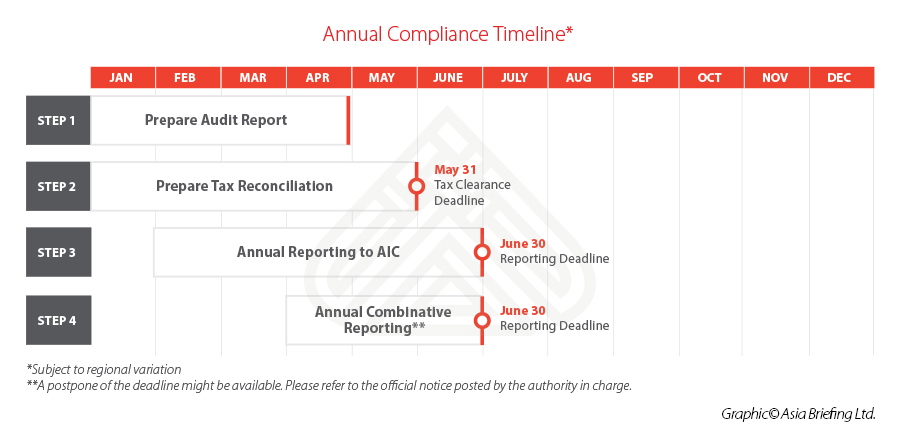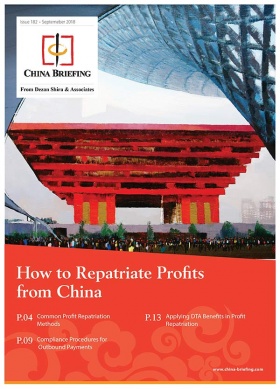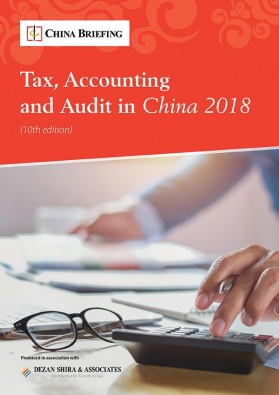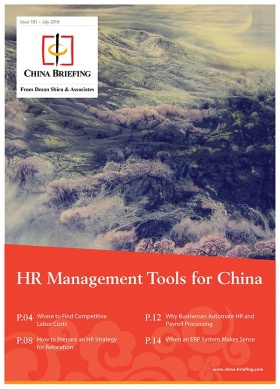Profit Repatriation from China: Compliance Procedures for Outbound Payments
During profit repatriation from China, there are specific compliance requirements for each channel the foreign invested entity (FIE) may choose.
Preparing in advance can substantially increase the likelihood of success and avoid corresponding risks.
In this article, we provide step-by-step guidance for the respective procedures through which firms can remit funds from China.
Profit repatriation from China: Procedures for remitting funds as dividends
Step 1: Annual audit and tax compliance
Generally, only profit that has undergone annual audit and tax compliance process can be repatriated.
This process allows tax authorities to make sure all Corporate Income Tax (CIT) has been paid up with regard to the profits being distributed.
Annual audit for tax compliance in China involves producing a statutory annual audit report, a CIT reconciliation report, and reporting to relevant government bureaus.
The relevant procedures and key considerations vary slightly by region and entity type. It is usually completed around June every year (see accompanying timeline).
The tax authorities will also confirm the maximum profit amount that can be repatriated based on the net profit indicated in the financial reports.
That is to say, the accumulated losses should have been made up and the mandatory reserves fund has been properly withdrawn.
Notably, the annual audit process can only be used to repatriate the profits acquired in the past accounting year.
In case the FIE wants to remit the accumulated profits in the previous years or postpone the profit distribution to the following years due to a cash flow concern, an additional special audit report will be required.
Step 2: Reach the profit distribution resolution
To decide how much profit the FIE will distribute to its shareholders and when to remit, the FIE’s board of directors or executive director should draft a profit distribution plan.
Upon shareholder’s approval, the profit distribution plan becomes a resolution.
For repatriation of accumulated profits in the other year, the profit distribution resolution should be reached prior to the special audit.
Step 3: Self-assessment of applicability for DTA benefits
Prior to the withholding CIT filing, overseas shareholders who are tax residents of countries that have effective double tax avoidance agreements (DTA) with China may determine whether the DTA benefits are applicable to them by themselves; this usually entails a ‘beneficial owner’ assessment.
They can enjoy the preferential withholding tax rates upon withholding tax filing without needing pre-approval from the tax bureaus. However, they should still gather and retain relevant materials pursuant to relevant laws and regulations for future inspection, and the tax bureau may conduct follow-up supervision afterwards.
Generally, an “Information Reporting Form for Non-resident Taxpayers Claiming Treaty Benefits” should be submitted to the tax authorities at the time of withholding CIT filing, and the below materials must be gathered and retained:
- Tax resident identity proof issued by the tax authorities of the other treaty contracting party to prove the taxpayer’s tax residency status in the current year or the preceding year during which the payment is received. To claim benefits under the international transport clause of a treaty or benefits under an international transport agreement, the tax resident identity proof may be replaced by a certificate proving that the taxpayer satisfies the identity stipulated in the treaty or agreement;
- Proof of ownership, such as payment receipt, contracts, or agreements regarding the payment, resolution of the board of directors, or shareholders meeting, which are related to the income derived;
- Relevant materials that can prove the beneficial owner identity of the taxpayer; and
- Any other materials for which the taxpayer deems to be able to prove its satisfaction of criteria for claiming treaty benefits.
Step 4: Withholding CIT filing
For repatriation of profits as dividends to overseas investors, the FIE is obliged to withhold the relevant tax and file to the tax bureaus in charge within seven days of the tax obligation arises. There are online options available for this step now.
In practice, some companies may pay all withholding tax at once during the annual CIT reconciliation process. However, this is not advised – considering the compliance risks.
Step 5: Record-filing with tax bureau in charge (if outbound payment is over US$50,000)
For outbound payments with an equivalent value of more than US$50,000, the company is required to conduct record filing with the tax bureau in charge.
Companies must fill in a filing form and provide valid contracts, or other relevant transaction documents, to the tax bureau.
In the case of remitting dividend, a CIT withholding contract should be provided.
The tax bureau will focus on the below aspects:
- Whether the information filled into the filing form is consistent with the actual payment items;
- Whether corresponding taxes have been paid off; and
- Whether the DTA benefits has been properly used, in case the company applied for preferential tax rates.
Upon verifying the documents submitted, the tax which will affix a seal to the filing form.
Step 6: Dividend remittance (or bank payment)
The FIE can remit a dividend in the bank by submitting the below materials:
- The application form for profit remittance;
- Profit distribution resolution;
- Financial audit reports;
- Tax record-filing form as required in Step 5; and
- Proof material that the register capital of the FIE has been paid within the time limits as set out in the Articles of Association.
Procedure for paying intercompany service fees
Step 1: Contract registration with tax bureau in charge (for onshore service)
For contracting projects to non-residents, or accepting service provided by non-residents, the FIE needs to make a record-filing of the service contract within 30 days of the contract’s agreement.
Step 2: Self-assessment of applicability for DTA benefits
If there is a DTA in place between China and the jurisdiction in which the parent company is incorporated, the services provided in China by the overseas parent company through its employees or personnel may be exempt from CIT.
The FIE and overseas parent company can determine whether the DTA benefits are applicable and enjoy the DTA benefits during withholding tax filing.
For service fees, besides the beneficial owner assessment, the company needs to make sure the services are provided within a certain period.
If the service activities continue (for the same or a related project) for a continuous or cumulative period, such as 183 days within any 12-month period, a permanent establishment (PE) will be constituted.
If so, the DTA benefits of CIT exemption won’t apply, and the service income attributable to the PE will be subject to 25 percent CIT.
As detailed in Step 3 of the previous section, the company needs to submit an “Information Reporting Form for Non-resident Taxpayers Claiming Treaty Benefits” to the tax bureaus and retain certain materials for review and monitoring purposes.
Step 3: Withholding tax filing
Service fees are generally subject to VAT and surcharges, which are around 6.72 percent in total.
For CIT, services rendered outside China are exempt from CIT, while services rendered or deemed to be rendered in China will be subject to CIT at 25 percent, calculated on the deemed profit rate of 15 to 50 percent.
Chinese companies are advised to specify the offshore services that it received in the relevant service agreements and be prepared to clarify the nature of the services in case the tax bureau makes a challenge.
The Chinese subsidiary serves as the withholding agent. Accordingly, it needs to complete withholding VAT and withholding CIT filings, respectively, within the mandated period.
In addition, companies are required to do quarterly CIT reconciliation and submit relevant financial statements for non-one-off projects/agreements.
Step 4: Record-filing with tax bureau in charge (if outbound payment is over US$50,000)
This step follows the same process as what is introduced in Step 5 of the first section.
Step 5: Bank payment
As an item under current account, there is generally no extra limits for outbound payment of service fees.
However, in practice, the bank usually will examine the rationality and the authenticity of the transaction, following the guidance issue by State Administration of Foreign Exchange (SAFE).
The below document might be required by the bank to achieve the payment:
- Service contract; and
- The invoices issue by the service provider, the payment notice, or the other documents that can prove the rationality and authenticity of the transaction.
Procedures for royalties
Step 1: Contract registration
If the royalties are paid for importing of technology and know-how – which include patent transfer, patent application right transfer, patent licensing, know-how licensing, as well as technical service agreement – the company will need to register the contract with the local commerce bureau.
Generally, the below materials will be required:
- Application form to introduce the basic information of the technology import;
- Photocopy of the contract with company chops (Chinese translation or briefing will be required);
- Photocopy of the FIE’s business license, Ministry of Commerce (MOFCOM) approval or record-filing letter, or the foreign trade dealer/operator filing certificate;
- Photocopy of the registration certificate of the foreign party;
- If the royalty will be paid in the form of commission, the FIE needs to provide additional documents on the commission fee, such as a detailed statement of commission calculation, a special audit report, or the financial statements of the company; and
- The latest audit report of the FIE.
If the royalties are paid for trademark licensing or transfer, the company will need to register the contract with the trademark office.
Step 2: Self-assessment of applicability for DTA benefits
Again, as detailed above, the FIE and overseas parent company can determine whether the DTA benefits are applicable to them by themselves and enjoy the preferential withholding CIT rates during withholding tax filing.
The self-determination should be based on the beneficial owner assessment.
As detailed in Step 3 of the previous section, the company needs to submit an “Information Reporting Form for Non-resident Taxpayers Claiming Treaty Benefits” to the tax bureaus and retain certain materials to the tax bureaus for review and monitoring purposes.
Step 3: Withholding tax filing and payment
Royalties are generally subject to 6.72 percent VAT and surcharges, and 10 percent withholding CIT, which can be reduced to a lower rate if there is a valid DTA applicable.
The Chinese entity acts as an agent to withhold the tax on royalties at the source. It needs to make withholding VAT and withholding CIT filings, respectively, within the specified period.
In addition, companies are required to do quarterly CIT reconciliation and submit relevant financial statements for non-one-off projects/agreements.
Step 4: Record-filing with tax bureau in charge (if outbound payment is over US$50,000)
This step follows a similar process as what is described in Step 5 of the first section.
Step 5: Bank payment
Similar to service fee payment, the bank will examine the rationality and the authenticity of the transaction. However, the below documents might be required:
- Relevant contract; and,
- The invoices, the payment notice, or the other documents that can prove the rationality and authenticity of the transaction.
Procedures for extending loans
As an item under the capital account, extending loans to overseas parties face higher scrutiny from SAFE.
Step 1: Apply to the local SAFE in charge for extending overseas loans
For offshore loans that are less than 30 percent of the owners’ equity, the FIE can make a register with SAFE by submitting the offshore lending agreement and the most recent financial statements.
In the case that offshore loans over 30 percent of the owners’ equity shown in the financial report, the application will be subject to a case-by-case examination and approval.
The below documents are generally required for submission:
- Application form;
- Offshore lending agreement;
- The loaner’s most recent financial audit reports;
- Table of the stock of RMB offshore loans;
- Proof documents of the related party relationship between the loaner and the borrower; and
- Other documents required by the people’s bank or the SAFE in charge.
Upon the proper submission of the documents, the SAFE in charge will make decision within 20 working days.
Step 2: Open a bank account specifically used for extending offshore loans
If the SAFE in charge approves the offshore loan application, the Chinese subsidiaries can open a special bank account in the bank appointed by the SAFE.
All monetary transactions regarding the offshore loan must be through this special account, including the remittance of the loan from China to abroad, and the repayment of the loan and the interest from oversea to China.
Step 3: Bank payment
For companies that extend offshore loans with their self-owned funds, they can apply to the bank to make loan payments directly by submitting the registration and approval documents issued by the SAFE in charge.
(This article was originally published November 14, 2018. It was last updated August 24, 2020.)
About Us
China Briefing is written and produced by Dezan Shira & Associates. The practice assists foreign investors into China and has done so since 1992 through offices in Beijing, Tianjin, Dalian, Qingdao, Shanghai, Hangzhou, Ningbo, Suzhou, Guangzhou, Dongguan, Zhongshan, Shenzhen, and Hong Kong. Please contact the firm for assistance in China at china@dezshira.com.
We also maintain offices assisting foreign investors in Vietnam, Indonesia, Singapore, The Philippines, Malaysia, Thailand, United States, and Italy, in addition to our practices in India and Russia and our trade research facilities along the Belt & Road Initiative.
- Previous Article China Reinstates Import Tax Reduction and Exemption for 20 Commodities
- Next Article The US-China Trade War: A Timeline









